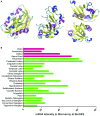Hypoxia-Inducible Factor-1α Target Genes Contribute to Retinal Neuroprotection
- PMID: 28289375
- PMCID: PMC5326762
- DOI: 10.3389/fncel.2017.00020
Hypoxia-Inducible Factor-1α Target Genes Contribute to Retinal Neuroprotection
Abstract
Hypoxia-inducible factor (HIF) is a transcription factor that facilitates cellular adaptation to hypoxia and ischemia. Long-standing evidence suggests that one isotype of HIF, HIF-1α, is involved in the pathogenesis of various solid tumors and cardiac diseases. However, the role of HIF-1α in retina remains poorly understood. HIF-1α has been recognized as neuroprotective in cerebral ischemia in the past two decades. Additionally, an increasing number of studies has shown that HIF-1α and its target genes contribute to retinal neuroprotection. This review will focus on recent advances in the studies of HIF-1α and its target genes that contribute to retinal neuroprotection. A thorough understanding of the function of HIF-1α and its target genes may lead to identification of novel therapeutic targets for treating degenerative retinal diseases including glaucoma, age-related macular degeneration, diabetic retinopathy, and retinal vein occlusions.
Keywords: HIF-1α; hypoxia preconditioning; neuroprotection; retina; retinal degeneration.
Figures


Similar articles
-
Oxygen-dependent diseases in the retina: role of hypoxia-inducible factors.Exp Eye Res. 2006 Sep;83(3):473-83. doi: 10.1016/j.exer.2006.01.016. Epub 2006 Jun 5. Exp Eye Res. 2006. PMID: 16750526 Review.
-
Inhibition of the HIF-1α/BNIP3 pathway has a retinal neuroprotective effect.FASEB J. 2021 Aug;35(8):e21829. doi: 10.1096/fj.202100572R. FASEB J. 2021. PMID: 34314069
-
Hypoxia inducible factor-1alpha is increased in ischemic retina: temporal and spatial correlation with VEGF expression.Invest Ophthalmol Vis Sci. 1999 Jan;40(1):182-9. Invest Ophthalmol Vis Sci. 1999. PMID: 9888442
-
Inhibition of HIF-1α decreases expression of pro-inflammatory IL-6 and TNF-α in diabetic retinopathy.Acta Ophthalmol. 2017 Dec;95(8):e746-e750. doi: 10.1111/aos.13096. Epub 2016 Jun 11. Acta Ophthalmol. 2017. PMID: 27288252
-
The role and regulation of hypoxia-inducible factor-1alpha expression in brain development and neonatal hypoxic-ischemic brain injury.Brain Res Rev. 2009 Dec 11;62(1):99-108. doi: 10.1016/j.brainresrev.2009.09.006. Epub 2009 Sep 25. Brain Res Rev. 2009. PMID: 19786048 Review.
Cited by
-
Inhibition of VHL by VH298 Accelerates Pexophagy by Activation of HIF-1α in HeLa Cells.Molecules. 2024 Jan 18;29(2):482. doi: 10.3390/molecules29020482. Molecules. 2024. PMID: 38257395 Free PMC article.
-
Metabolic theory of preeclampsia: implications for maternal cardiovascular health.Am J Physiol Heart Circ Physiol. 2024 Sep 1;327(3):H582-H597. doi: 10.1152/ajpheart.00170.2024. Epub 2024 Jul 5. Am J Physiol Heart Circ Physiol. 2024. PMID: 38968164 Review.
-
Dynamic changes of inducible nitric oxide synthase expression in rat's retina and its role on blood-retinal barrier injury after acute high intraocular pressure.Int J Ophthalmol. 2022 Jul 18;15(7):1053-1061. doi: 10.18240/ijo.2022.07.03. eCollection 2022. Int J Ophthalmol. 2022. PMID: 35919326 Free PMC article.
-
Glial type specific regulation of CNS angiogenesis by HIFα-activated different signaling pathways.Nat Commun. 2020 Apr 24;11(1):2027. doi: 10.1038/s41467-020-15656-4. Nat Commun. 2020. PMID: 32332719 Free PMC article.
-
HIF‑1α overexpression improves the efficacy of human induced pluripotent stem cell‑derived cardiomyocytes for cardiac repair following myocardial infarction.Mol Med Rep. 2025 Feb;31(2):40. doi: 10.3892/mmr.2024.13405. Epub 2024 Nov 29. Mol Med Rep. 2025. PMID: 39611463 Free PMC article.
References
-
- Ando H., Natsume A., Iwami K., Ohka F., Kuchimaru T., Kizaka-Kondoh S., et al. . (2013). A hypoxia-inducible factor (HIF)-3α splicing variant, HIF-3α4 impairs angiogenesis in hypervascular malignant meningiomas with epigenetically silenced HIF-3α4. Biochem. Biophys. Res. Commun. 433, 139–144. 10.1016/j.bbrc.2013.02.044 - DOI - PubMed
-
- Augstein A., Poitz D. M., Braun-Dullaeus R. C., Strasser R. H., Schmeisser A. (2011). Cell-specific and hypoxia-dependent regulation of human HIF-3α: inhibition of the expression of HIF target genes in vascular cells. Cell. Mol. Life Sci. 68, 2627–2642. 10.1007/s00018-010-0575-4 - DOI - PMC - PubMed
Publication types
LinkOut - more resources
Full Text Sources
Other Literature Sources
Miscellaneous

